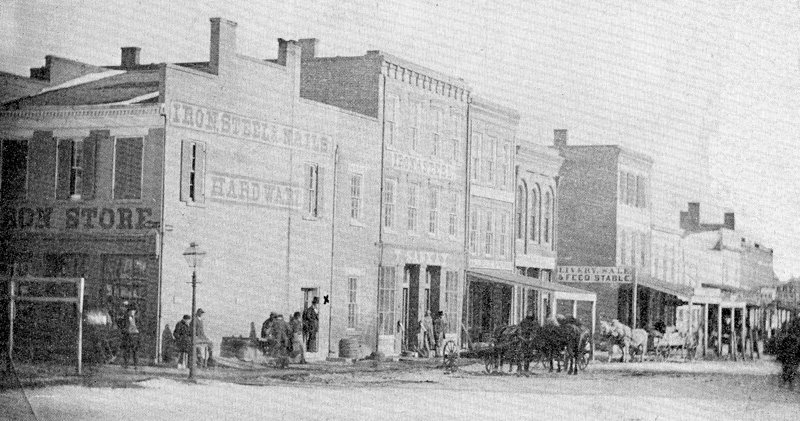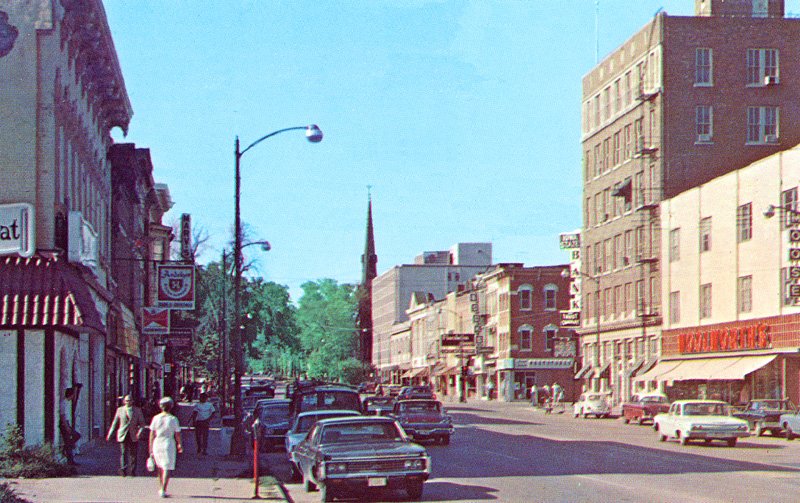
The
Iowa territorial legislature first met in Iowa City in 1841 in a building very
near “the Whetstone corner”
Whetstones
(1876-1973) still occupies the Clinton-Washington streets corner north of Iowa
State Bank in this postcard image recorded
By Bob Hibbs The Iowa territorial legislature first met in Iowa City for 54 days during late 1841 and early 1842, passing 127 laws on such issues as roads, ferries, dams, private and municipal incorporations, divorce and $24,412 in total appropriations, including $3 to a local justice of the peace.
It was the legislature’s fourth session, following three in Burlington. It met in a two-story wood building facing Washington Street just east of Clinton called Butler’s Capitol, a landmark during the subsequent decade. The session a year later would be held on the main floor of Old Capitol since its top floor remained unfinished.
The first facility was built by Walter Butler, prominent owner of an adjoining hotel. He was unpaid for erecting or use of the facility since legislators had agreed to meet in Iowa City only if furnished a rent-free accommodation. Butler died two years later at age 43, while serving as Johnson County sheriff. That first local session was opened Monday, Dec. 6, 1841, and ended Friday, Feb. 18, 1842, a period of 75 days, of which legislators met 54 days, less than half the length of modern sessions.
The governor then was New Jersey native John Chambers, a Kentucky lawyer who during the War of 1812 served on general’s staff of future president William Henry Harrison. In 1841 Harrison appointed Chambers to a four-year term as governor of Iowa Territory succeeding Robert Lucas. Chambers, who had arrived in Burlington in May 1841, had a message read to those assembled in Iowa City. In it he called for a popular vote on statehood, continued work on Old Capitol, a penitentiary at Fort Madison, a conscientious objector status in law, and settling the boundary question with Missouri in the Supreme Court, which was done.
Chambers didn’t like Iowa City, built a home near Burlington which he called Grouseland, and throughout his term performed gubernatorial duties from there whenever the legislature was not in session in Iowa City.
Among laws past that session, one-fourth dealt with roads with laws to “locate and establish,” or “relocate” or “review” a particular route. Typical was appointment of three men “to lay out and establish” a road from Crawfordsville through New London to a point called Smith’s Mills, all in Henry County. They were to be paid $1.50 daily for their work.
Next most attention was to ferries, including setting “duty and liability” of ferry keepers. None touched Johnson County since previous sessions had established crossings of the Iowa River at Iowa Avenue and near what is now the Benton Street.
Municipal corporation status was offered to Iowa City, but voters continued to ignore it for another decade, thinking county and state entities were enough government. Decrepit streets, unfenced livestock and rowdy bars eventually changed enough minds that Iowa City government was established in 1853. Among 10 private corporations authorized during the session was one for the Iowa City Mechanic’s Mutual Aid Association which built the Mechanic’s Academy the following summer on a Linn Street site set aside for school use. The academy served as first home to local public schools, the University of Iowa, both University and Mercy hospitals and other important local institutions.
The Butler’s Capitol corner began serving Sanxay hardware about 1850, then landmark Whetstone Drug from 1876 until 1973. After Butler’s January 1844 death, heirs failed on a mortgage, and through court proceedings the site was purchased by Frederick Sanxay in 1848. He sold to son Theodore in 1862, who rented to Whetstone Drug in 1876.
The property was sold to Peter Dey in 1893 whose heirs owned it until 1948 when it was purchased by William Byington and Everett Moss, who had acquired Whetstone Drug from Robert Whetstone.
The corner is certainly one of Iowa City’s many historic sites.
Next
Saturday:
Iowa City’s 1881 Glass Works.
Bob
Hibbs collects local postcards and researches history related to them.
|
